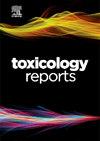Liver morphometry and histopathology effects in Astyanax lacustris exposed to lambda-cyhalothrin pyrethroid insecticide
Q1 Environmental Science
引用次数: 0
Abstract
Lambda-cyhalothrin (LC) is a pyrethroid insecticide employed to manage various arthropods as an alternative to persistent insecticides with minimized toxic effects on birds and mammals. However, LC causes oxidative and neurotoxic damages in fish Danio rerio. Effects of LC in morphology of liver of fishes are scare. We aimed to establish the lethal concentration (LC50 96 h) of pyrethroid LC for Astianax lacustris. Then, we compare liver responses of sublethal doses of LC (i.e. 10.30 µg/L) for acute (i.e 1- and 3-days post-exposure - dpe) and chronic (i.e 6 and 12 dpe). We sought to identify pathological changes and compare liver histometric remodeling in fish subjected to acute and chronic toxicity tests. For this, liver histological changes were evaluated using the degree of tissue changes (DTC), followed by histomorphometric techniques determining structural volumetric density, glycogen cell density, and morphometry of hepatic tissue. We observed high hepatocellular injuries in exposed fishes. The main injuries included leukocyte infiltration, hyperemia, and pyknotic nuclei, especially 6 dpe. Hepatic glycogen storage decreases at 6 and 12 dpe showing metabolic damage. Both, density and volume of decreases after LC exposure in all exposure time. However, sinusoidal density increases after LC exposure, suggesting vascular hyperemia. These results show morphophysiological effects of LC at 10.30 µg/L in acute and chronic exposure represented by decreased glycogen storage, structural density, and volume of hepatocytes, in addition to a higher degree of histological changes.
氯氟氰菊酯对湖虾肝脏形态及组织病理学的影响
高效氯氟氰菊酯(LC)是一种拟除虫菊酯杀虫剂,用于管理各种节肢动物,作为持久性杀虫剂的替代品,对鸟类和哺乳动物的毒性作用最小。然而,LC可引起斑马鱼的氧化和神经毒性损伤。LC对鱼类肝脏形态的影响尚不清楚。目的建立拟除虫菊酯类杀虫剂对湖腹天牛的致死浓度(LC50 96 h)。然后,我们比较了急性(即接触dpe后1和3天)和慢性(即6和12 dpe)亚致死剂量的LC(即10.30 µg/L)的肝脏反应。我们试图确定病理变化和比较肝脏组织重塑的鱼遭受急性和慢性毒性试验。为此,使用组织改变程度(DTC)评估肝脏组织学变化,随后使用组织形态学技术确定肝组织的结构体积密度、糖原细胞密度和形态计量学。我们在暴露的鱼类中观察到高度的肝细胞损伤。主要损伤为白细胞浸润、充血、核固缩,尤以6dpe为主。肝糖原储存在6和12 dpe时减少,显示代谢损伤。在所有曝光时间内,LC曝光后的密度和体积均有所下降。然而,LC暴露后,正弦密度增加,提示血管充血。这些结果表明,10.30 µg/L的LC对急性和慢性暴露的形态生理影响,表现为糖原储存、结构密度和肝细胞体积的降低,以及更高程度的组织学改变。
本文章由计算机程序翻译,如有差异,请以英文原文为准。
求助全文
约1分钟内获得全文
求助全文
来源期刊

Toxicology Reports
Environmental Science-Health, Toxicology and Mutagenesis
CiteScore
7.60
自引率
0.00%
发文量
228
审稿时长
11 weeks
 求助内容:
求助内容: 应助结果提醒方式:
应助结果提醒方式:


